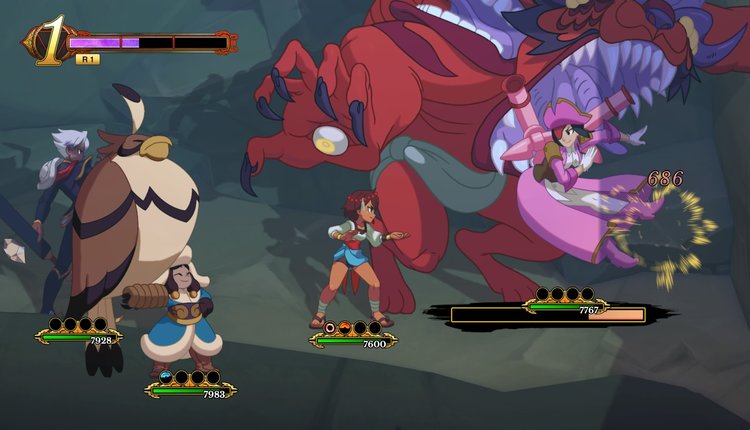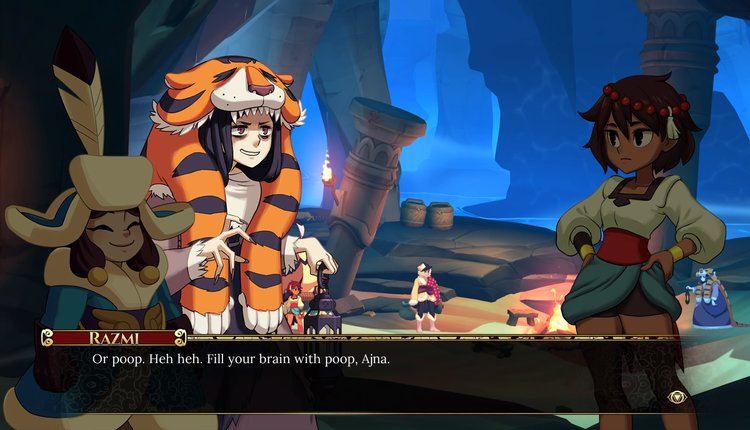Game Review: Indivisible is a Cracked Pearl Combo of JRPG and Fighting Game
I was standing in College Green the other day, killing time, and one of the battle themes from Indivisible popped into my head. Once I worked it out, I tried to see how many more I could remember from memory alone; before long, I’d gone through most of the major tunes and in all likelihood sent a few tourists running scared from the crazy humming man on Dame Street.
I’ve been excited for this game ever since the Kickstarter was announced in 2015 and blew me away with its gorgeous demo. At its best, the game recaptures the intensity of that experience, bursting with energy as the screen explodes with audio-visual fireworks, and makes a real impression. Unfortunately, the game’s many issues reminds you of just how rushed Indivisible feels right now.
First things first though: this game pops.
A flashy Studio Trigger opening sets the bar for presentation high. The music, from legendary composer Hiroki Kikuta, is catchy and upbeat but takes a backseat to the truly jaw-dropping visuals on display in this hybrid of a real-time and turn-based RPG from developers Lab Zero. Indivisible Project Lead Mike Zaimont was design lead on Lab Zero’s previous project Skullgirls, a hand-animated fighting game. Veteran animator Mariel Kinuko Cartwright serves as Creative Director, with top billing for animation and story.
Creative move sets compliment beautiful hand-drawn animation, all vibrant smears and dramatic key poses. Pirate Queen Baozhai uses shoulder mounted rockets to fly across the screen and do a booty smash, archer Zebei uses his bow like a skateboard in mid-air and plant-wrangler Nuna sprouts trees to uppercut unsuspecting enemies. An energetic script from Lead Writer Brandon Sheffield brings these characters to life, from the dude-bro duo of “Tlatchlibol” players, one using the other as a ball to launch at enemies, to the lovable Razmi, an unhinged shaman that keeps a tiger spirit in her lantern.
The majority of the work is done by some impressive voice acting as the story of Indivisible is primarily told with visual-novel style dialogue sections. Tania Gunadi is fantastic as Ajna, a hot-blooded teenager who sets out for revenge after her father is murdered and her village destroyed by the forces of general Ravannavar. Hardly ground breaking stuff, but here’s the catch: Ajna can absorb other characters with high levels of Iddhi into her mind as she journeys to save the world from destruction by the goddess Kala. This starts with her father’s murderer, the indoctrinated soldier Dhar, and expands to include over 20 companions by the end of this 25-odd hour campaign.
At times, this feels like a fascinating extension of the companion system best known in Bioware titles like Baldur’s Gate or Mass Effect. Here, Ajna houses every party member inside her picturesque Inner Realm, a literal mind palace. This keeps the entire roster chiming in and out of conversations throughout the campaign and acts as a nice visual shorthand for Ajna’s expanding worldview and character development.
The anime-styled character designs are nicely varied, drawing on a range of religious and mythological inspirations such as “Ajna” both referring to the lead character and the Third-Eye chakra. It’s also nice to have a story with such a diversity of ages, races and sexualities, simply treating these as individual aspects of multifaceted characters.

Unfortunately, the main narrative feels disjointed. The rapid set-up of Indivisible fails to sell the relationship between Ajna and her father, made all the more tonally bizarre by her joking around roughly 30 minutes later. Dhar sticks out like a sore thumb; Ajna and co will be having a good time before ganging up on Dhar to insert some ham-fisted inter-party conflict into the otherwise light-hearted proceedings. Despite this, his is one of the more interesting arcs in a narrative that, to its credit, sees its characters adapt and change to the world around them.
Admirably, Indivisible directly challenges Ajna’s shoot-first-ask-later approach so typical of video game protagonists. However, the writing continuously beats you over the head with the consequences of your actions. It’s genuinely interesting when you talk to villagers afraid for their lives after something Ajna did, but not so much the tenth time the game reminds you.
A surprisingly large amount of your time will be spent platforming through the gorgeous levels, including a jungle temple, a bustling desert port and a mermaid’s nightclub. Ajna carries momentum into jumps, encouraging you to chain dashes into pike jumps and axe climbing, the smooth flow of abilities sold by some chunky sound design. Platforming is satisfying and engaging, with optional collectibles providing you with genuinely difficult gauntlets that serve as nice palate cleansers between fights.
The intricate and granular combat is heavily inspired by Valkyrie Profile. You control four characters, each mapped to a face button on console, with different attacks produced by simple directional inputs. Characters can spend Iddhi to use super abilities, generally a burst of damage or healing. Choosing between spending additional Iddhi for more powerful effects adds a nice ebb and flow to combat.
[perfectpullquote align=”full” bordertop=”false” cite=”” link=”” color=”#70006C” class=”” size=”19"]”Despite all the polish poured into combat, it’s far too easy”.[/[/perfectpullquote]p>
Squeezing the right bumper slows the game down to a crawl, resembling more traditional turn-based gameplay. However, a combo meter builds with consecutive attacks, emblazoned across the screen in striking font, increasing your damage output and cleverly encouraging you to lean into the real-time elements of combat.
Melee characters have to run across the screen before attacking, creating pockets of delay that allows you to set up dazzling attack strings. Knocking an airborne enemy down with a ranged character before catching them mid-fall with an axe swing, all while you load a full round into gunslinger Latigo’s six shooter and rev up an explosive shell in thief Kampan’s buster gauntlet to extend the combo, feels ridiculously satisfying.
Combat encourages experimentation and rewards you for thinking outside the box. For example, mid-game enemies leech health away when touched, a problem for a primarily melee fighter like Ajna. However, launching them with a ranged character and timing Ajna to intentionally whiff her first attack allows you to fire arrows from her bow without taking damage.
Each character introduces a new dimension to combat, asking you to leverage positioning and timing in a way that’s hugely indebted to fighting games but cast in a remarkably fresh light in an RPG setting. For example, travelling adventurer Leilani can use her shark-tooth chainsaw to gather all your enemies up in the dead centre of the screen, her deadly whirlwind the perfect setup for Ajna’s focused hadouken blast. Despite all the polish poured into combat, it’s far too easy.
Enemies generally attack one of your characters at a time, bar the odd AOE claw swipe, and their damage output is comedically low for the majority of Indivisible. Factor in trappers that can halt incoming attacks and encounters with any less than three enemies at a time completely lack any sense of challenge. Arguably, it’s in service of the game’s light and breezy atmosphere, keeping things moving at a rapid clip. However, it makes supports and medics functionality useless, as well as never forcing you to engage with all of the wonderful micro mechanics.
Damningly, it also means that you never really need to rejig your team composition in a team-based RPG, bar one or two rare occasions, and I often found myself intentionally avoiding the increasingly repetitive fights (bizarrely, there’s no option to retreat mid-combat as of writing). Certain enemies need to be juggled in mid-air, a smart re-purposing of a fighting game system, but this is a rare example in a game that never forces you to engage past the surface level of its mechanics. Boss fights are a proper mixed bag. The better ones face you off against huge monsters with supporting mobs, at least forcing you to consider target prioritisation.
Lab Zero combine distinct real time sections (like dodging volleys of bullets) with turn based battles. However, the battles are almost always unsatisfying; an epic encounter against a gigantic Serpent Queen feels pretty anticlimactic when you juggle half of her lifebar away before she’s gotten a single hit in. There’s also the unfortunate case of Garuda Cruel; how fun does it sound to fight a boss with literally two different attacks, floating helplessly during turn-based sections, where the music keeps cutting out? How about doing it twice?
Indivisible commits the ultimate campaign structure sin; “The Devil May Cry 4“. Like in that character action title, the second half sees you backtracking through previously visited locations fighting palate swapped enemies (and, unfortunately, the encore of Garuda Cruel). This drains some of the momentum built during the first 15 hours, which climaxes with some lovely character moments and an impressive spectacle battle.

Optional character-specific side quests are introduced bizarrely late, asking you to backtrack through the same environments for a third time. However, it’s well worth powering through. The ending is genuinely moving, with a ridiculously over-the-top finale powered by a suite of energetic tracks from Kikuta.
Overall, it’s hard not to feel disappointed at the cracks in the façade. Balance patches are ongoing but Indivisible needs some serious work under the hood. Still though, what a journey. After four years of waiting, it’s a thrill to blast through the story with your gang of fighting-game superheroes, a rallying cry for teamwork and positivity in an industry too often dominated by darkness and irony.

